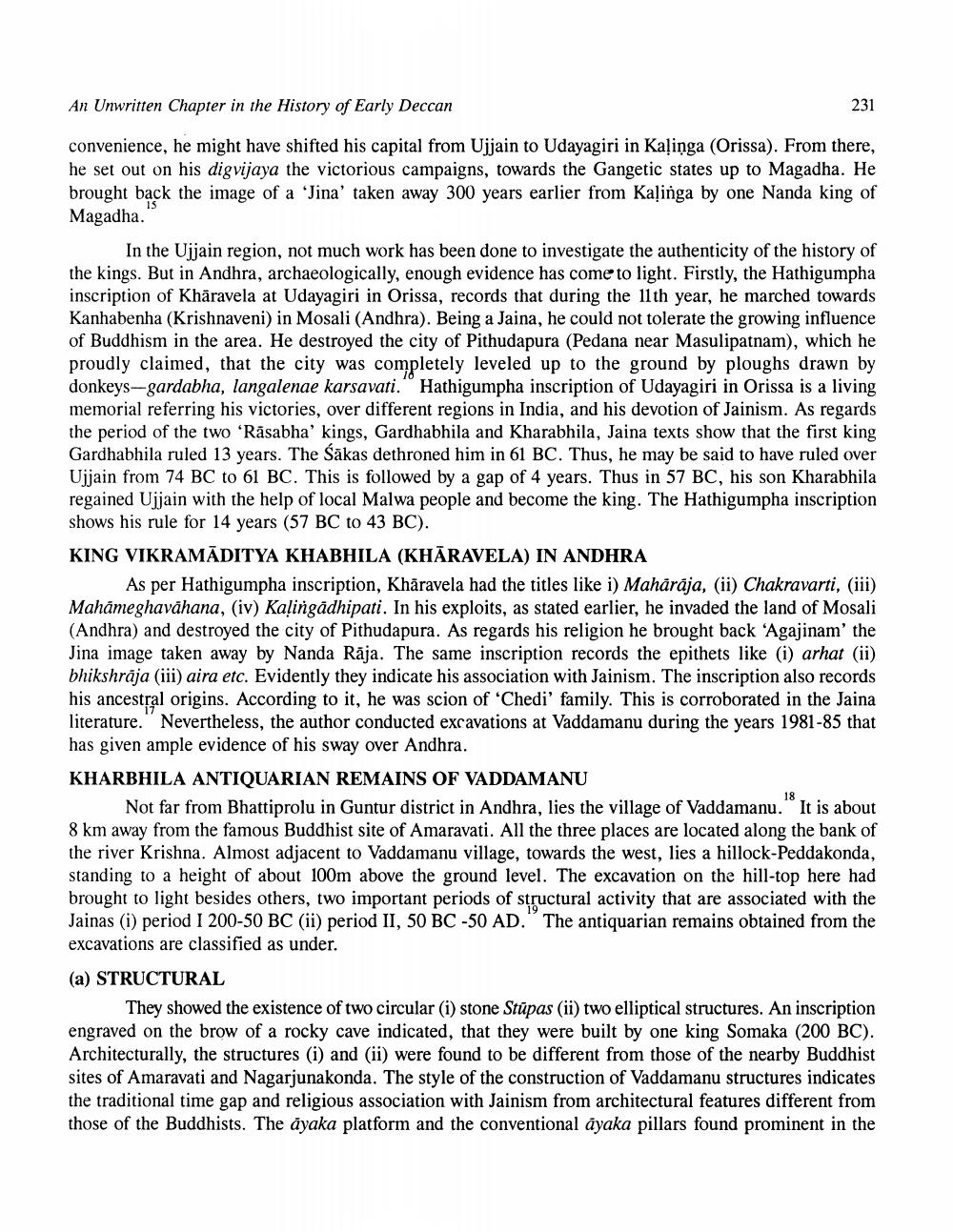________________
An Unwritten Chapter in the History of Early Deccan
convenience, he might have shifted his capital from Ujjain to Udayagiri in Kalinga (Orissa). From there, he set out on his digvijaya the victorious campaigns, towards the Gangetic states up to Magadha. He brought back the image of a 'Jina' taken away 300 years earlier from Kalinga by one Nanda king of Magadha.
231
In the Ujjain region, not much work has been done to investigate the authenticity of the history of the kings. But in Andhra, archaeologically, enough evidence has come to light. Firstly, the Hathigumpha inscription of Khāravela at Udayagiri in Orissa, records that during the 11th year, he marched towards Kanhabenha (Krishnaveni) in Mosali (Andhra). Being a Jaina, he could not tolerate the growing influence of Buddhism in the area. He destroyed the city of Pithudapura (Pedana near Masulipatnam), which he proudly claimed, that the city was completely leveled up to the ground by ploughs drawn by donkeys-gardabha, langalenae karsavati." Hathigumpha inscription of Udayagiri in Orissa is a living memorial referring his victories, over different regions in India, and his devotion of Jainism. As regards the period of the two 'Rasabha' kings, Gardhabhila and Kharabhila, Jaina texts show that the first king Gardhabhila ruled 13 years. The Sākas dethroned him in 61 BC. Thus, he may be said to have ruled over Ujjain from 74 BC to 61 BC. This is followed by a gap of 4 years. Thus in 57 BC, his son Kharabhila regained Ujjain with the help of local Malwa people and become the king. The Hathigumpha inscription shows his rule for 14 years (57 BC to 43 BC).
KING VIKRAMADITYA KHABHILA (KHÄRAVELA) IN ANDHRA
As per Hathigumpha inscription, Khäravela had the titles like i) Mahārāja, (ii) Chakravarti, (iii) Mahāmeghavahana, (iv) Kalingadhipati. In his exploits, as stated earlier, he invaded the land of Mosali (Andhra) and destroyed the city of Pithudapura. As regards his religion he brought back 'Agajinam' the Jina image taken away by Nanda Raja. The same inscription records the epithets like (i) arhat (ii) bhikshrāja (iii) aira etc. Evidently they indicate his association with Jainism. The inscription also records his ancestral origins. According to it, he was scion of 'Chedi' family. This is corroborated in the Jaina literature." Nevertheless, the author conducted excavations at Vaddamanu during the years 1981-85 that has given ample evidence of his sway over Andhra.
KHARBHILA ANTIQUARIAN REMAINS OF VADDAMANU
18
Not far from Bhattiprolu in Guntur district in Andhra, lies the village of Vaddamanu." It is about 8 km away from the famous Buddhist site of Amaravati. All the three places are located along the bank of the river Krishna. Almost adjacent to Vaddamanu village, towards the west, lies a hillock-Peddakonda, standing to a height of about 100m above the ground level. The excavation on the hill-top here had brought to light besides others, two important periods of structural activity that are associated with the Jainas (i) period I 200-50 BC (ii) period II, 50 BC -50 AD." The antiquarian remains obtained from the excavations are classified as under.
(a) STRUCTURAL
They showed the existence of two circular (i) stone Stūpas (ii) two elliptical structures. An inscription engraved on the brow of a rocky cave indicated, that they were built by one king Somaka (200 BC). Architecturally, the structures (i) and (ii) were found to be different from those of the nearby Buddhist sites of Amaravati and Nagarjunakonda. The style of the construction of Vaddamanu structures indicates the traditional time gap and religious association with Jainism from architectural features different from those of the Buddhists. The dyaka platform and the conventional ayaka pillars found prominent in the




